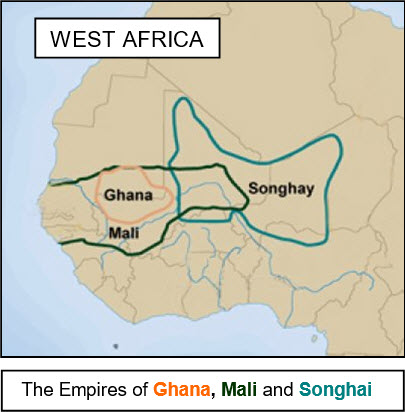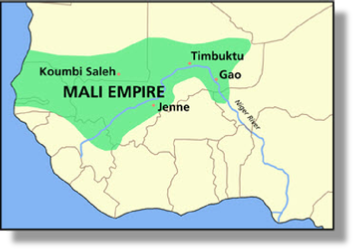


THE MALI EMPIRE 1235 (H3)
xxxxxThe Ancient Kingdom of
Ghana, as we have seen, flourished in West Africa from the 800s, but
began to break up following the invasion of the Almoravids in 1076 (W1). For a time the Susu
people took over the remnants of the empire, but in 1235
one of the leaders of the Malinke tribe, Sundiata, over-
 xxxxxAs we have seen, it was in 1076
(W1) that the Ancient
Kingdom of Ghana (see
map), which had flourished in West Africa
from the 800s, was overrun by the Muslim Almoravids. Whilst the
occupation only lasted for a few years, it was sufficient to
seriously disrupt the trade upon which the empire so much depended.
Neighbouring clans, once subject to and dependent on this powerful
trading nation, now broke away and claimed independence.
xxxxxAs we have seen, it was in 1076
(W1) that the Ancient
Kingdom of Ghana (see
map), which had flourished in West Africa
from the 800s, was overrun by the Muslim Almoravids. Whilst the
occupation only lasted for a few years, it was sufficient to
seriously disrupt the trade upon which the empire so much depended.
Neighbouring clans, once subject to and dependent on this powerful
trading nation, now broke away and claimed independence.
xxxxxOne such clan, the Susu, under its ruler King Sumanguru, created a small empire by overrunning some of these small states. Then in 1203 Sumanguru occupied the capital of Ghana, Kumbi Saleh, intent upon reviving its fortunes as the centre of the lucrative trade routes that crossed the Sahara. His harsh rule, however, and his inability to maintain law and order worked against him. Soon after his occupation the traders abandoned Kumbi Saleh in favour of more stable trading centres, and his kingdom came under attack.
 xxxxxOne of the peoples who
revolted against the harsh rule of King Sumanguru were the Malinke,
the inhabitants of the small state of Kangaba on the Upper Niger
River. In about 1235 one of their leaders,
Sundiata, won a
decisive victory over Sumanguru at the Battle
of Kirina, and took over his ailing
kingdom. Within a few years Sundiata had consolidated his rule and
formed what came to be known as the Mali
Empire. In 1240 he razed Kumbi Saleh to the
ground, thus destroying the last vestige of the ancient Kingdom of
Ghana, and soon afterwards moved his capital to Niani. This new site
was on the trade routes across the Sahara and soon became a major
commercial centre in the Sudan. Meanwhile, his generals began to
expand southwards towards the gold-
xxxxxOne of the peoples who
revolted against the harsh rule of King Sumanguru were the Malinke,
the inhabitants of the small state of Kangaba on the Upper Niger
River. In about 1235 one of their leaders,
Sundiata, won a
decisive victory over Sumanguru at the Battle
of Kirina, and took over his ailing
kingdom. Within a few years Sundiata had consolidated his rule and
formed what came to be known as the Mali
Empire. In 1240 he razed Kumbi Saleh to the
ground, thus destroying the last vestige of the ancient Kingdom of
Ghana, and soon afterwards moved his capital to Niani. This new site
was on the trade routes across the Sahara and soon became a major
commercial centre in the Sudan. Meanwhile, his generals began to
expand southwards towards the gold-

xxxxxWe shall see (1324 E2), that the Mali Empire, centred on the Upper Niger River, was destined to become the most powerful and prosperous of all the empires of the western Sudan. It reached the height of its power and influence in the reign of its leader Mansa Musa, (about 1307 to 1337) and by then covered an area similar to that once occupied by the Empire of Ghana. It was not finally destroyed until the latter part of the fifteenth century, when, in its turn, it gave way to the Songhai Empire (shown above).
xxxxxIncidentally, when Sumanguru, the leader of the Susu, overran the state of Kangaba at the beginning of the thirteenth century, he murdered all of Sundiata's brothers but, according to tradition, spared Sundiata himself because he was a sick child and thought to be near to death. For Sumanguru this proved a fatal decision!
H3-
Acknowledgements
Map (West Africa): licenced
under Creative Commons –
https://resourcesforhistoryteachers.wikispaces.com. Map (Mali Empire): licensed under Creative Commons -


